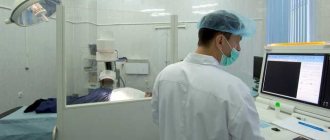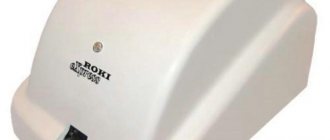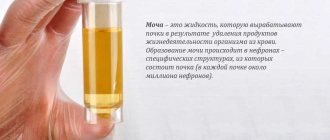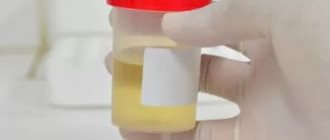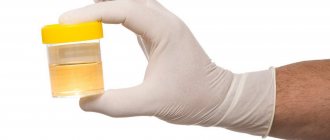Types of analyzes
Laboratory research is one of the accurate diagnostic methods. Medicine distinguishes 2 large subgroups of tests: specific and nonspecific.
What is included in the specific group:
- according to Nechiporenko - helps to identify pyelonephritis or urethritis;
- according to Zimnitsky - analyzes the functionality of the kidneys;
- for sugar - detects diabetes mellitus and determines the condition of the pancreas;
- for protein - shows infectious diseases and inflammation;
- hCG - reliably detects pregnancy;
- Rehberg test - determines the value of creatinine.
Nonspecific - general urine test. Based on its results, the level of red blood cells, protein, white blood cells, the presence of salts, mucus, bacteria and some other indicators are revealed.
How to prepare properly
For greater reliability, before submitting biomaterial, you must adhere to the following rules:
- exclude alcoholic beverages the day before urine collection;
- do not eat carrots, berries;
- stop using medications that affect the composition of the biomaterial;
- do not take diuretics.
Before donating urine for analysis, perform morning hygiene procedures. For a general urine test, you should collect the morning “medium stream” (begin and end in the toilet, and the rest is collected in a container).
General recommendations
General rules for collecting and storing analyzes boil down to:
- Carrying out hygiene procedures before collecting biomaterial. This will help prevent epithelial cells and genital secretions from getting into the urine.
- Tracking your daily diet. On the eve of the test, it is recommended to refrain from dyeing products, after which the urine may become tinted. Also, do not eat fried or other foods that are difficult for the stomach.
- Store in closed containers to prevent contamination of germs. Also, you should not collect urine in advance and store it.
Follow all the rules and doctors’ explanations, and then you will correctly collect and donate urine, which will ensure the correct diagnosis.
Shelf life
Experts advise storing urine collected for analysis for no more than 2 hours. Long-term storage of urine with subsequent donation is unacceptable, since not only the physical properties change, but bacteria also appear and the sediment is destroyed.
In addition, laboratory technicians detect an increase in pH value, which occurs due to the activity of pathogenic microorganisms. Also, during long-term storage, it will not be possible to preserve bile pigments, since they are destroyed by daylight.
Type and storage time
In order to store the analysis most correctly, you need to reliably know the type of research being carried out.
How long is biomaterial stored before delivery? Let's consider the main types of analyzes and terms of maintenance.
- General analysis. It is taken in the morning, on an empty stomach. Storing such urine before donation is undesirable. When delivering it to the laboratory, make sure that the urine does not become too cold or frozen.
- According to Zimnitsky. The analysis consists of 8 bowel movements per day, which are collected in a special container. During this period, urine should be kept cold to avoid changes in its properties. By the way, in order to prevent any changes in the structure, you can add special chemicals to the container, which were described above, but do not forget that as a result of this, the urine becomes cloudy. Long-term storage of biomaterial is unacceptable, so try to hand it over to the laboratory the next morning.
- According to Nechiporenko. It is necessary to collect an average portion of the analysis in the morning and immediately send the urine to the laboratory. According to Nechiporenko, urine can be stored for 1 hour, since there is a high probability of bacteria development. Even infants are tested.
- Daily urine or the Kakovsky-Addis method. This examination method is used extremely rarely to identify dangerous genitourinary diseases. The analysis must also be collected within 24 hours. Is it possible to store a jar of urine in the refrigerator? Yes, this is permissible, but first you should drop a couple of drops of formaldehyde there. However, remember that in this case the urine may become opaque.
- Three-glass sample. Urine is given in the morning after 5 hours of abstinence. Urine does not last long, only 1 hour. Experts also say that urine should be kept at room temperature in a special container.
Prevention of bedsores
Bedsores are skin ulcers of varying sizes and depths. Most often they appear in seriously ill patients in the sacral area, less often in the area of the shoulder blades, the back of the head, buttocks, heels and other places where soft tissues are compressed between the bone and the bed. The first sign is pale skin, then redness, swelling and peeling of the epidermis. Subsequently - blisters and necrosis of the skin. In severe cases, necrosis can affect not only soft tissue, but also cartilage and even bone. The following manipulations can help prevent bedsores:
- if the patient’s condition allows, it is necessary to change his position in bed several times a day;
- Wash areas of possible formation of bedsores with warm water and soap, and then wipe with camphor alcohol;
- do a simple massage of areas of the body where bedsores may form;
- make sure there are no wrinkles or food crumbs on the sheet;
- for seriously ill patients who have been in bed on their back for a long time, place an inflatable rubber circle placed in a pillowcase so that the sacrum is above its opening;
- in case of hyperemia (redness), rub the skin with a dry towel, and to improve local blood circulation, irradiate the affected area with a quartz lamp;
- wash the skin with soap and water at room temperature, and then wipe it with alcohol and powder with talcum powder.
How to save longer
If for some reason it is not possible to promptly return the container, then you should know how to store urine for analysis. Such situations occur when there are problems with urination (for example, when a person is unable to wait until the morning to collect morning urine), when collecting urine from a child, or in connection with personal or work situations. In such cases, the collected urine can be stored in the refrigerator until delivery.
In the wall of the refrigeration chamber, urine for analysis should only cool down. The ambient temperature cannot be below +4 degrees. Therefore, a compartment in the refrigerator door or the lowest shelf is suitable for storage. Remember that if you put urine in the refrigerator, its relative density will probably change. Therefore, record this fact in the direction or tell the laboratory assistant about it.
Sometimes doctors prescribe 24-hour urine samples for testing. But you can’t store biomaterial for more than 2 hours, what should you do in this case?
Chemical preservatives come to the rescue. Let's look at some of them:
- Thymol. Add 2 crystals for every 100 ml;
- Boric acid. 3-4 granules per 100 ml;
- Toluene. A small amount of the substance, approximately 2 ml, is poured into the container. After some time, you may notice that the urine has become cloudy.
- Glacial acetic acid. It is added to the entire volume of urine in an amount of 5 ml.
Children's question
The procedures and timing described above are intended for adults. But how to properly collect and store a child’s biomaterial, are there any differences?
It is recommended to take tests in portions of 100-150 ml.
For an adult, getting such a volume is not difficult, but collecting material from a newborn sometimes turns into a whole problem. Special children's urine collectors, which are sold in every pharmacy, come to the aid of young parents. The design of the device is a small polyethylene container with a special hole with Velcro. Thanks to this, you can easily attach a urine bag to your child. There is no need to place it under the diaper, as the device may come off.
It is extremely undesirable to collect baby urine in a potty due to the high content of bacteria, dust and other harmful microorganisms in it. By the way, this is one of the reasons for cloudy urine. Some people mistakenly believe that the pot can be easily washed with special products, but this is not the case. Therefore, if it is not possible to buy a special urine collector, you can use sterilized glass jars and bags.
You can store the collected biomaterial for 2 hours, because after this period the urine has a cloudy hue and an accumulation of bacteria in it. Of course, you can store urine in the refrigerator, but you should not allow excessive hypothermia and freezing. When you take your urine to the laboratory, be sure to notify the laboratory technician about the method and time of storage of the material. This will make certain adjustments to the study.
Collected urine should not be stored for long periods of time as it is subject to rapid composition changes. Ideally, biomaterial should be delivered to the laboratory immediately after collection. If this is not possible, place the container in the refrigerator on the lowest shelf or in the wall. But remember that such storage should be short-lived, only 2 hours.
nefrox.ru
Dementia in the elderly: taking medications, urine testing, hygiene and toileting
As an older person with dementia worsens, their quality of life depends less on medication and more on care. Patients with dementia most often die not due to the underlying disease, but from accidents, worsening infections and other events that can be delayed or prevented if you know how to properly care for your loved one.
General rules
Urinalysis can be used to diagnose and evaluate the course of various diseases. Therefore, there will be several options for submitting urine for testing. The most common is a general urine test. Its results may indicate the functioning of the organs of the urinary system, but some indicators indicate endocrine pathology, heart disease, and rheumatic ailments.
What points must be observed to collect urine correctly:
- The day before the test, you should review your diet and exclude foods, and, if necessary, medications that can change the color of biological fluid: beets, blueberries, vitamin preparations, some anti-tuberculosis drugs. Discontinuation of medications should be recommended by a physician.
- You should not abuse any one product the day before, which can change the acidity of urine and cause the appearance of salts, which will lead to incorrect interpretation of the results.
Immediately before urinating, hygiene procedures should be carried out. It is not necessary to use chemical intimate hygiene products for washing. It is better to wash yourself with clean running water in sufficient quantities. In addition, it is not advisable to use wet wipes before donation.
It is important to know that women should not donate urine during menstruation. No matter how well hygienic procedures are carried out, microscopy may reveal increased white blood cells or the appearance of protein.
What studies are required?
When pregnancy occurs, all organs and systems begin the process of restructuring and transformation. These changes are associated with the formation of a new organism. The kidneys and the entire urinary system function with double load, because they now need to cope not only with the decay products of the mother’s body, but also the child’s. During pregnancy, the urinary system is very sensitive to negative environmental manifestations. The uterus increases in size and puts pressure on abdominal organs such as the bladder, ureters and kidneys.
When pregnancy occurs, all organs and systems begin the process of restructuring and transformation
With an increased amount of progesterone, the urinary tract reduces its tone and expands. Stagnation occurs, which can otherwise be characterized as a violation of the outflow; they lead to an imbalance, so even the mildest infection can lead to a serious inflammatory process, which will negatively affect the baby’s health.
That is why, to prevent dangerous conditions, taking a urine test is one of the most important, accessible, and informative methods of examining the body. If you correctly collect biological material and conduct high-quality laboratory research, you can detect even the most hidden pathological processes. Modern medicine allows for a wide variety of diagnostic measures, however, urine analysis retains a confident first place.
To assess the condition, the attending specialist prescribes a mandatory test on the day of the visit, as well as by the twentieth and thirtieth week of pregnancy. Not everyone knows why and how to donate urine correctly, this is what we have to figure out. A general analysis allows the doctor to see the overall picture of the woman’s condition. If any indicators do not correspond to the norm, then we can conclude that a pathological process is present. The presence of acetone is a consequence of liver dysfunction and a manifestation of toxicosis; glucose indicates diabetes mellitus. In the second trimester, protein is often found in the urine. If the pressure is increased and swelling is present, then we can assume the presence of gestosis.
How to submit material?
If you are taking a general urine test, you can collect biological fluid at home in a sterile jar, which can be purchased at a pharmacy. Do not use packaging for baby food, sour cream, or yogurt. To get rid of the remaining food product, you will need to wash the jar very thoroughly, or better yet, boil it. However, this will not give a 100% guarantee that no bacteria will be detected in the analysis.
A frequently asked question to any doctor is whether it is possible to collect urine for analysis in the evening. This cannot be done. A general urine test is taken exclusively in the morning, and the first portion of urine should be taken. Why you need to consider several recommendations:
- It is the first urine collected in the morning after the night that will provide the most reliable information about existing changes. The concentration of pathological impurities and cells (urinary sediment) will be maximum, which will allow the doctor to make the most correct diagnosis.
- The collected analysis should not stand for a long time, even if it is submitted in the morning. The longer urine sits in a container, the greater the chance that bacteria will get into it.
To obtain a reliable result, it is important to correctly collect the analysis. To do this, after hygiene procedures, the woman must spread her labia, and the man must free the head of the penis from the foreskin. The very first, as well as the last, drops of biological fluid do not need to be collected. It is necessary to collect exactly the average portion, which most fully reflects the state of the urinary system.
Urine must be delivered in a container with a tight lid. It is advisable not to shake the container vigorously to avoid contact of the liquid with the lid. Urine should not be frozen or heated.
If it is impossible to collect a test from a child in a natural way, you can buy special containers for collecting urine at the pharmacy. The device is attached with adhesive tape to the child’s skin on the genitals, and it will not interfere with the baby. Before collecting biological fluid, both adults and children need to perform genital hygiene.
There is also a 24-hour urine test, Nechiporenko urine test, etc. They are prescribed less often, but also have their own characteristics. Therefore, before taking the test, it is better to consult a doctor, because the result of the study and subsequent treatment of the disease depend on this.
nefrolab.ru
What studies are required?
When pregnancy occurs, all organs and systems begin the process of restructuring and transformation. These changes are associated with the formation of a new organism. The kidneys and the entire urinary system function with double load, because they now need to cope not only with the decay products of the mother’s body, but also the child’s. During pregnancy, the urinary system is very sensitive to negative environmental manifestations. The uterus increases in size and puts pressure on abdominal organs such as the bladder, ureters and kidneys.
When pregnancy occurs, all organs and systems begin the process of restructuring and transformation
With an increased amount of progesterone, the urinary tract reduces its tone and expands. Stagnation occurs, which can otherwise be characterized as a violation of the outflow; they lead to an imbalance, so even the mildest infection can lead to a serious inflammatory process, which will negatively affect the baby’s health.
That is why, to prevent dangerous conditions, taking a urine test is one of the most important, accessible, and informative methods of examining the body. If you correctly collect biological material and conduct high-quality laboratory research, you can detect even the most hidden pathological processes. Modern medicine allows for a wide variety of diagnostic measures, however, urine analysis retains a confident first place.
Urine collection rules
The key to obtaining reliable test results is the correct collection technique.
There are several options for donating biological fluid for research. Most often, a general urine test is required. With the help of such diagnostics, it is possible to identify a large number of pathological processes that occur in the body and not only in the urinary system.
In order not to distort the results, urine must be collected according to the following rules:
- About a day before collecting biological fluid, you need to adjust your diet and stop taking certain medications. It is not recommended to consume: apples, blueberries, beets, vitamins, anti-tuberculosis drugs, etc. This can change not only the color of the urine, but also its composition.
- You should not overuse any one product, as its high concentration in the body can distort the results due to changes in acidity or cause the appearance of salts.
- Genital hygiene. Before collecting urine, it is not recommended to use detergents to care for the intimate area. You need to take a shower or perform hygienic treatment of the genitals by washing with clean water.
- Menstruation. It is not recommended to donate urine to women during menstruation, since even with high-quality hygienic procedures, foreign elements can get into the biological material. If such a recommendation is ignored, laboratory test results may reveal an increased content of leukocytes or protein may be detected.
Kakovsky-Addis method
To calculate formed elements in daily quantities using the Kakovsky-Addis method, one of the conditions for conducting this study is some restriction of fluid intake during the examination period: the patient should not drink at night and drink less during the day. At the same time, the relative density of urine (1020 - 1025) and its pH (5.5) are standardized, which is very important when judging the number of hyaline casts, which easily dissolve in alkaline and low-concentrated urine with low relative density and persist longer in acidic and concentrated urine with high relative density. Urine is collected within 10–12 hours. The patient urinates before going to bed (this portion of urine is poured out), notes the time and after 10 - 12 hours urinates in the prepared dishes. This portion of urine is delivered to the laboratory for testing. If it is impossible to hold back urination for 10–12 hours, the patient urinates in the prepared dishes in several steps and notes the time of the last urination.
Procedure for collecting biological material
Most people collect urine for analysis at home. A common mistake that patients make is a poorly washed container. For this reason, in order not to spoil the diagnosis, it is recommended to purchase a sterile container that is specifically designed for such purposes.
If the patient has been prescribed a referral for a general urine test, then it cannot be collected in the evening. In addition, a portion of the biological fluid donated for research should be collected immediately after waking up, that is, the first emptying of the bladder after a night's sleep. During the night, the kidneys produce more concentrated urine, and therefore it is considered more informative.
Interim urine must be submitted for analysis. That is, the first and last drops of urine are not collected. In addition, after all hygienic procedures, a woman, before starting to empty her bladder into a container, needs to carefully spread her labia. The man needs to expose the genital organ, freeing it from the foreskin.
After the biological material has been collected, the container is covered with a tight lid, the jar is labeled or a direction for analysis is attached to it. After this, you need to deliver the tests to the laboratory as soon as possible. During transportation, you should handle the container carefully and do not shake it. If possible, the collected material can be placed in the refrigerator during transportation, but the liquid cannot be frozen.
To test the urine of a small child and get the most accurate results, you can purchase a special children's kit at the pharmacy. It is attached to the genitals using adhesive tape. When purchasing, you need to specify whether the container is for a boy or a girl. The fact is that they are made for different sexes, taking into account the physiological characteristics of the structure.
2pochki.com
Is it possible to collect a child’s urine for analysis in the evening?
- No, this absolutely cannot be done.
The fact is that various bacteria spread very quickly in urine. And you need to collect urine for analysis immediately before delivery - in the morning. For an accurate analysis, you only need freshly collected urine, which is no more than 2-3 hours old.
- No, you absolutely cannot do this. If you collect urine for analysis in the evening, then after standing all night it will be filled with a huge number of bacteria that will change its chemical composition. An analysis of such urine will not be correct and may show that there are disorders or abnormalities in the body.
- To conduct a general urine test, you need to take the child’s morning urine and quickly take it to the laboratory. The time from urine collection to analysis should not exceed 2-2.5 hours (for the analysis to be correct).
It is important to wash the child before collecting urine. And also, if possible, take a medium stream of urine (not at the beginning of urination or at the end, but in the middle).
- No you can not. Because bacteria may appear in the urine overnight, and this may be a false sign of a urinary tract infection. Therefore, you only need to collect the morning urine sample to obtain a reliable result.
- Of course, no, it’s impossible - any biological fluids intended for analysis are not intended for storage for any long time - the longer the period, the more distorted the results can be. You will need to collect urine in the morning, no more than two hours before going to the clinic. Before collecting urine, the child must be washed, and, as already noted here, it is advisable to take the liquid that is released in the middle of the urination process.
- No, it’s not just that quot; freshquot; is required. morning urine. The composition of morning and evening urine is different. The morning one is more informative. During the night, all the main indicators (leukocines, red blood cells, etc.) accumulate in the urine and are compared with the norm.
Before taking the test, it is necessary to carry out hygiene procedures, but it is not advisable to use soap.
- Unlike stool, which can be collected in the evening, urine tests only need to be collected in the morning.
And the point is not that it will disappear or deteriorate overnight, but that during the night the volume of urine accumulates in the bladder in which it is best possible to accurately determine the number of red blood cells, leukocytes, proteins, etc.
This will help to identify all inflammatory processes that may be in the kidneys or bladder, or vice versa - to confirm that the child does not have any inflammation or deviations from the norm.
After all, what is important to parents is the exact result, and not that the urine was given, but what kind of urine it was: morning or evening, what’s the difference.
- Infections in a child’s body can develop very quickly and test results in the morning and evening can vary greatly. Therefore, it is better to try to do this in the morning, because in the morning the child will do what is needed. The parent’s task is to have time to collect material for analysis.
- The results of urine collected in the evening and in the morning can be very different. Since urine collected in the morning a few hours before delivery will show reliable test results, but urine that has stood for more than 4 hours may not show anything at all or, on the contrary, reveal replenishment of which there is no.
- No, the pediatrician told us that it was impossible. If you bring evening urine for diagnosis, the test result may be unreliable.
It is necessary to collect the first morning urine. Before collecting the baby, it is advisable to wash it. If the child does not yet go to the potty, it is better to use a special urinal for collection.
- Urine should be collected only in the morning as soon as the child wakes up, and if you collect urine in the evening, the composition of the urine will change and the tests will show the wrong result. So you can’t collect urine in the evening.
info-4all.ru
Zimnitsky test
To carry out the Zimnitsky test, 8 portions of urine are collected per day. At 6 o'clock in the morning the patient empties his bladder (this portion is poured out). Then, starting at 9 a.m., exactly every 3 hours, collects 8 portions of urine in separate jars (until 6 a.m. the next day). The time of urine collection is marked on each jar. All portions are delivered to the laboratory, where the quantity and relative density of each portion is measured. The test is carried out with the patient’s usual drinking regimen and nutrition; no preliminary preparation of the patient is required, but it is advisable to warn the patient that it is desirable that the amount of liquid on this day does not exceed 1 - 1.5 liters.
